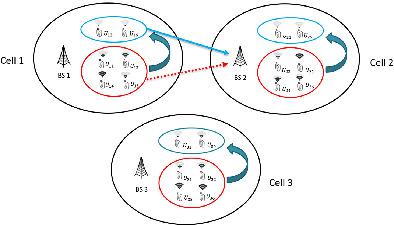当前位置:
X-MOL 学术
›
Trans. Emerg. Telecommun. Technol.
›
论文详情
Our official English website, www.x-mol.net, welcomes your
feedback! (Note: you will need to create a separate account there.)
The interference alignment scheme based on subspace differentiation for multicell multiuser multiple‐input‐multiple‐output uplink channels
Transactions on Emerging Telecommunications Technologies ( IF 2.5 ) Pub Date : 2020-12-27 , DOI: 10.1002/ett.4198 Shibao Li 1 , Wei Ye 1 , Lin Guo 1 , Jianhang Liu 1 , Tingpei Huang 1 , Xuerong Cui 1 , Yucheng Zhang 2
Transactions on Emerging Telecommunications Technologies ( IF 2.5 ) Pub Date : 2020-12-27 , DOI: 10.1002/ett.4198 Shibao Li 1 , Wei Ye 1 , Lin Guo 1 , Jianhang Liu 1 , Tingpei Huang 1 , Xuerong Cui 1 , Yucheng Zhang 2
Affiliation

|
The traditional subspace interference alignment (IA) schemes in the multicell multiuser multiple‐input‐multiple‐output (MIMO) network align interference into the multidimensional subspace to reduce the dimension of the interference space, but the choice of subspace is random, and the difference between users is not considered. Such schemes may leave large intercell interference when the difference between users is large. To solve this problem, this article proposes the IA scheme based on subspace differentiation for multicell multiuser MIMO uplink channels. First, based on the transmit power and the distance to base stations in other cells, each user analyzes the interference value it will cause. The interference value of each user is represented by actual interference power (AIP). Within each cell, the users are reordered according to the AIP. When performing interference reduction, the signals of the users with large interference are merged into the subspace composed of the signals of the users with small interference, which can further reduce the final intercell interference. The multidimensional merge weight is assigned according to the AIP. The smaller the interference value of the dimension, the more interference it merges. The experimental simulation data show that the scheme implemented in this article can improve the proportion of the desired signals in the received signals of the receivers, thereby improving the overall system rate. When the user difference in transmit power and distance is large, the proposed scheme has a particularly obvious advantage.
中文翻译:

多小区多用户多输入多输出上行信道基于子空间差分的干扰对准方案
多小区多用户多输入多输出(MIMO)网络中的传统子空间干扰对齐(IA)方案将干扰对齐到多维子空间中,以减小干扰空间的维数,但是子空间的选择是随机的,且差异很大用户之间不考虑。当用户之间的差异较大时,此类方案可能会留下较大的小区间干扰。为了解决这个问题,本文针对多小区多用户MIMO上行信道提出了一种基于子空间差分的IA方案。首先,根据发射功率和到其他小区的基站的距离,每个用户分析它会引起的干扰值。每个用户的干扰值由实际干扰功率(AIP)表示。在每个单元中,根据AIP对用户进行重新排序。在进行干扰降低时,将干扰较大的用户的信号合并到由干扰较小的用户的信号组成的子空间中,可以进一步减小最终的小区间干扰。多维合并权重是根据AIP分配的。尺寸的干扰值越小,合并的干扰就越大。实验仿真数据表明,本文实现的方案可以提高接收器接收信号中所需信号的比例,从而提高整体系统速率。当用户在发射功率和距离上的差异较大时,所提出的方案具有特别明显的优点。将干扰较大的用户信号合并到由干扰较小的用户信号组成的子空间中,可以进一步减少最终的小区间干扰。多维合并权重是根据AIP分配的。尺寸的干扰值越小,合并的干扰就越大。实验仿真数据表明,本文实现的方案可以提高接收器接收信号中所需信号的比例,从而提高整体系统速率。当用户在发射功率和距离上的差异较大时,所提出的方案具有特别明显的优点。将干扰较大的用户信号合并到由干扰较小的用户信号组成的子空间中,可以进一步减少最终的小区间干扰。多维合并权重是根据AIP分配的。尺寸的干扰值越小,合并的干扰就越大。实验仿真数据表明,本文实现的方案可以提高接收器接收信号中所需信号的比例,从而提高整体系统速率。当用户在发射功率和距离上的差异较大时,所提出的方案具有特别明显的优点。多维合并权重是根据AIP分配的。尺寸的干扰值越小,合并的干扰就越大。实验仿真数据表明,本文实现的方案可以提高接收器接收信号中所需信号的比例,从而提高整体系统速率。当用户在发射功率和距离上的差异较大时,所提出的方案具有特别明显的优点。多维合并权重是根据AIP分配的。尺寸的干扰值越小,合并的干扰就越大。实验仿真数据表明,本文实现的方案可以提高接收器接收信号中所需信号的比例,从而提高整体系统速率。当用户在发射功率和距离上的差异较大时,所提出的方案具有特别明显的优点。
更新日期:2020-12-27
中文翻译:

多小区多用户多输入多输出上行信道基于子空间差分的干扰对准方案
多小区多用户多输入多输出(MIMO)网络中的传统子空间干扰对齐(IA)方案将干扰对齐到多维子空间中,以减小干扰空间的维数,但是子空间的选择是随机的,且差异很大用户之间不考虑。当用户之间的差异较大时,此类方案可能会留下较大的小区间干扰。为了解决这个问题,本文针对多小区多用户MIMO上行信道提出了一种基于子空间差分的IA方案。首先,根据发射功率和到其他小区的基站的距离,每个用户分析它会引起的干扰值。每个用户的干扰值由实际干扰功率(AIP)表示。在每个单元中,根据AIP对用户进行重新排序。在进行干扰降低时,将干扰较大的用户的信号合并到由干扰较小的用户的信号组成的子空间中,可以进一步减小最终的小区间干扰。多维合并权重是根据AIP分配的。尺寸的干扰值越小,合并的干扰就越大。实验仿真数据表明,本文实现的方案可以提高接收器接收信号中所需信号的比例,从而提高整体系统速率。当用户在发射功率和距离上的差异较大时,所提出的方案具有特别明显的优点。将干扰较大的用户信号合并到由干扰较小的用户信号组成的子空间中,可以进一步减少最终的小区间干扰。多维合并权重是根据AIP分配的。尺寸的干扰值越小,合并的干扰就越大。实验仿真数据表明,本文实现的方案可以提高接收器接收信号中所需信号的比例,从而提高整体系统速率。当用户在发射功率和距离上的差异较大时,所提出的方案具有特别明显的优点。将干扰较大的用户信号合并到由干扰较小的用户信号组成的子空间中,可以进一步减少最终的小区间干扰。多维合并权重是根据AIP分配的。尺寸的干扰值越小,合并的干扰就越大。实验仿真数据表明,本文实现的方案可以提高接收器接收信号中所需信号的比例,从而提高整体系统速率。当用户在发射功率和距离上的差异较大时,所提出的方案具有特别明显的优点。多维合并权重是根据AIP分配的。尺寸的干扰值越小,合并的干扰就越大。实验仿真数据表明,本文实现的方案可以提高接收器接收信号中所需信号的比例,从而提高整体系统速率。当用户在发射功率和距离上的差异较大时,所提出的方案具有特别明显的优点。多维合并权重是根据AIP分配的。尺寸的干扰值越小,合并的干扰就越大。实验仿真数据表明,本文实现的方案可以提高接收器接收信号中所需信号的比例,从而提高整体系统速率。当用户在发射功率和距离上的差异较大时,所提出的方案具有特别明显的优点。











































 京公网安备 11010802027423号
京公网安备 11010802027423号